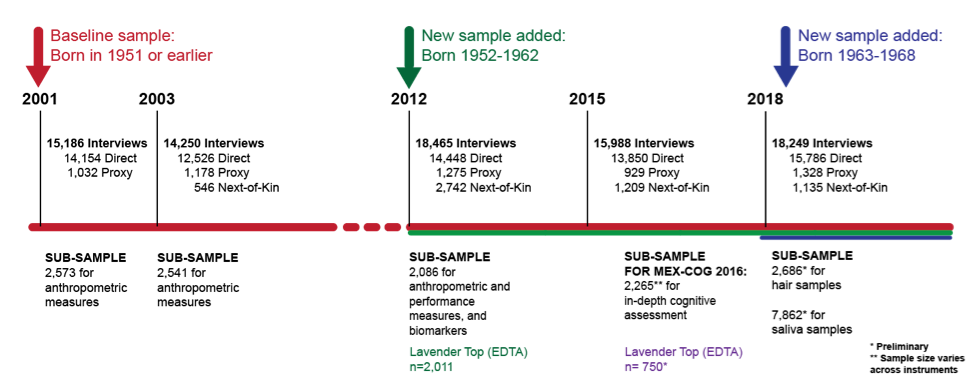Study Introduction: Mexican Health and Aging Study (MHAS)
Written by: Rebeca Wong and Alejandra Michaels-Obregon
Published on: Dec 17, 2020

The Mexican Health and Aging Study (MHAS/ENASEM) is a national longitudinal household survey for the study of health, economic status, and quality of life among persons aged 50 and over, and their spouses, regardless of age, in Mexico. The first survey of the MHAS was conducted in 2001 with follow-ups in 2003, 2012, 2015, and 2018. In addition to following the original sample, refreshment samples were added in 2012 and 2018. Starting in Wave 2, the MHAS protocol also included next-of-kin interviews regarding deceased participants (see MHAS Timeline below). The study was designed to prospectively evaluate the impact of disease on the health, function and mortality of adults living in private dwellings in both urban and rural areas in Mexico. The study protocols and survey instruments are highly comparable to the U.S. Health and Retirement Study (HRS). The data files and documentation are available free of charge on the study website. For more details on the study background and design, see Wong 2015 and MHAS 2013.

The MHAS is a collaborative effort among researchers from the University of Texas Medical Branch (UTMB), the Instituto Nacional de Estadística y Geografía (INEGI, Mexico), the University of Wisconsin, the Instituto Nacional de Geriatría (INGER, Mexico), the Instituto Nacional de Salud Pública (INSP, México), and University of California Los Angeles (UCLA).
MHAS data have been used by researchers around the world both alone and in combination with other Health and Retirement Studies. About 14 percent of the peer-reviewed publications involve cross-national comparisons. For example, Gerst et al. (2015) examines differences in the transitions of disability in Mexico and the United States. Crimmins et al. (2005) used MHAS data to study role of height and early life health in the selection of migrants and the “Hispanic Paradox” of better health and lower mortality than expected given social and economic status of Hispanic people in the United States. Riosmena et al. (2013) examined Mexico-United States migration selection and acculturation and their influence on old age health. Antman (2010) examined the effect of migration on the health of elderly parents whose children migrated to the United States. Kohler & Soldo (2010) investigated the interplay between characteristics of early childhood circumstances and diabetes in mid and late life. Monteverde et al. (2010) identified excess mortality risk among obese and overweight individuals in Mexico and the United States. Díaz-Venegas, Reistetter, and Wong (2018) used MHAS and the HRS data to identify important differences in the progression of disability between Mexico and the United States. Payne (2015) estimates disability-free life expectancy in Mexico, United States, Puerto Rico, and Costa Rica. Avila et al. (2020) examines how diabetes affects the trajectory of cognitive function differently in Mexico and the United States.
The MHAS data are contained in several files. The Harmonized MHAS data file incorporates data from the core interview data, the master follow-up file, household roster data, and next-of-kin data. Working with the Gateway to Global Aging Data team, the MHAS will also be releasing a Harmonized MHAS End of Life file focusing on the MHAS next-of-kin interview and a Harmonized Mex-Cog file focusing on the MHAS Harmonized Cognitive Assessment Protocol. All harmonized data files and documentation are available free of charge on the study website. The programming codes and documentation for the Harmonized MHAS are also available here. The MHAS is partly sponsored by the National Institutes of Health/National Institute on Aging (grant number NIH R01AG018016) in the United States and the Instituto Nacional de Estadística y Geografía (INEGI) in Mexico. The construction of the Harmonized MHAS data is funded by the National Institute on Aging (R01 AG030153).
Further Reading
- Wong, Rebeca, Alejandra Michaels-Obregon, and Alberto Palloni. First published online January 27, 2015. Cohort Profile - The Mexican Health and Aging Study (MHAS). Int. J. Epidemiol.
- MHAS. 2013. Mexican Health and Aging Study MHAS 2012, Sample Design.
Cited Research
- Antman, F. M. (2010). Adult child migration and the health of elderly parents left behind in Mexico. American Economic Review, 100(2), 205-08.
- Crimmins, E. M., Soldo, B. J., Ki Kim, J., Alley, D. E. (2005). Using anthropometric indicators for Mexicans in the United States and Mexico to understand the selection of migrants and the Hispanic paradox. Social Biology, 52(3-4), 164-177.
- Diaz-Venegas, C., Reistetter, T. A., Wong, R. (2018). Differences in the progression of disability - A US-Mexico comparison. The Journals of Gerontology Series B, 73(5), 913-922.
- Kohler, I. V., Soldo, B. J. (2005). Childhood predictors of late-life diabetes - the case of Mexico. Social biology, 52(3-4), 112-131.
- Monteverde, M., Noronha, K., Palloni, A., Novak, B. (2010). Obesity and excess mortality among the elderly in the United States and Mexico. Demography, 47(1), 79-96.
- Pagan, J. A., Ross, S., Yau, J., Polsky, D. (2006). Self-medication and health insurance coverage in Mexico. Health policy, 75(2), 170-177.
- Rebeca Wong is a Mexican scholar who received a Ph.D. in Economics from the University of Michigan in 1987. Currently a professor at the University of Texas Medical Branch. She has pioneered the use of cross-national approaches to study health outcomes among international migrants. She serves as Principal Investigator of the Mexican Health and Aging Study (MHAS).
- Alejandra Michaels-Obregon (M.Sc) is a Research Project Manager at the University of Texas Medical Branch.